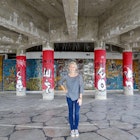

Just an hour from Hong Kong by high-speed ferry lies the former Portuguese colony of Macau. Its heritage architecture sits easily alongside incense-scented temples and shrines, and the Portuguese spoken by some long-time residents intermingles with local Cantonese and the Mandarin of the crowds from mainland China.
Though 24 hours is not nearly enough time to take in all of attractions, this itinerary will help you make the most of your day.
Morning: admire the traditional architecture

Start early and stroll along the shard-like Largo do Senado square, past , ВбВЙГІВЙГмтs most important historical building, which faces the square to the west. Grab a pastry and coffee at , a favourite with the local Portuguese and Macanese community, then head west through the Largo de SУЃo Domingo square for a peek at the Igreja de SУЃo Domingos т an appealing 17th-century Baroque church with a wealth of ecclesiastical art in its airy interior.
Carry on north along Rua de SУЃo Paulo and up some flights of stairs to ВбВЙГІВЙГмтs most famous landmark т the ruins of the 17th-century . Only the five-tiered facade is still standing, richly decorated with stone carvings of the Holy Virgin atop a dragon, Chinese lions and the infant Jesus. Through the gateway to nowhere you can see a skyscraper т a neat juxtaposition of the old and the new. Those with a taste for the macabre can stop by the crypt and ossuary to view the remains of martyred Japanese and Vietnamese Christians dating back to the 17th century.
Just east of the ruins, ride the escalator up to and pop into the very worthwhile , which captures the rich history of the colony, comparing and contrasting the cultures and achievements of China and through the centuries. Thereтs a playful element to the exhibits: you can press buttons to hear the cries of street vendors, and walk a miniature street lined with recreated traditional buildings. From the fort, walk three blocks southeast to the main Rua do Campo and catch bus 2 or 2A to Guia Hill.
You can either stroll up to , the highest point of the Macau Peninsula, with expansive views from its battlements, or take the from the Flora Gardens entrance. Walk past the dragon-shaped topiary to the whitewashed, picture-perfect , and check out what looks like contemporary art sculptures in the small gallery just below т these are symbols used to indicate the different strengths of a typhoon.
Itтs lunchtime now, so take any bus heading south along Rua do Campo, alight at Avenida de Praia Grande, and follow it to the splendid colonial , where you can grab a good-value Macanese lunch of tender ribs, roasted for 12 hours, or braised cod with black-eyed beans, accompanied by a fine selection of Portuguese wines.
Afternoon: soak up the atmosphere

Catch bus 6B southwest, past Sai Van Lake, for a visit to one of the cityтs most atmospheric temples т the 16th-century , dedicated to the goddess of the sea and fragrant with smoke from incense coils. Linger with the worshippers and scramble to the viewpoint overlooking the entire temple.
Cross the Sai Van Bridge, which connects Macau to and islands, also settled by the Portuguese, by taking bus 21A all the way south to the sleepy seafront . Duck into , renowned among the Macanese for its take on the local speciality of pastУЉis de nata (custard tarts). After a stroll along the beach, take the same bus back up to for a wander through the narrow streets, lined with Chinese shops, temples and local houses. Then head east along the tree-lined esplanade of Avenida da Praia to visit the for a look at the restored colonial villas т former summer residences of Taipaтs affluent Macanese citizens т and to explore traditional occupations such as firework-making and fishing.
Evening: glittering casinos and bird's-eye views

Youтll be feeling pangs of hunger by this point, but fear not: Taipa Village has an excellent dining scene for such a tiny place. Try refined for the traditional Portuguese caldo verde (cabbage soup) and baked bacalhau com natas (codfish with cream) or, for a less expensive option, check out the informal , with its Portuguese sausage, chicken casserole and grilled sardines.
Macau, the only place in China where gambling is legal, isnтt called the 'Monte Carlo of the Orient' for nothing. This means there are plenty of options for after-dinner entertainment. The Cotai Strip that connects Taipa with Coloane is lined with casinos and luxury resort complexes. Head there to catch the , a playful mix of acrobatics, swimming stunts and light show, at the , followed by a night with the high rollers at the blackjack and poker tables of the т the worldтs largest casino.

Alternatively, if you felt that Fort Guia wasnтt high enough, take bus 26 from Taipa Village north to the 338m-tall on the Macau Peninsula and get whisked to the observation deck on the 58th floor for unforgettable 360-degree views of the glittering Macau skyline. If youтre an adrenaline fiend, launch yourself off the outdoor deck on the 61st floor by means of the worldтs highest bungee jump, or else stroll its exposed perimeter with nothing but a harness keeping you from the abyss.
A more relaxing way to finish the evening is to kick back with a cocktail and a view at , a short bus or taxi hop up Avenida Doutor Stanley Ho, or else by heading east along Avenida Dr Sun Yat Sen to the NAPE harbourfront nightlife district, where you can take your pick of stylish or casual nightspots.
Explore related stories










